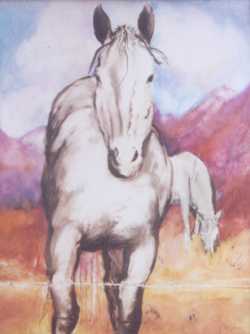Article by Clint Driscoll
Local artist – February 2002 – Colorado Central Magazine
IT’S IMPOSSIBLE to walk past a Fay Golson work without stopping to look. Whether the piece is a highly textured, colorful painting of humans at work, or a photograph of an abandoned shack in a blizzard, or a photogram featuring the demon form of Kali among everyday objects, the work requires examination and a reaction. That phenomenon has established the reputation of this Chaffee County artist as a painter, maker of mixed-media pieces, and a very creative photographer.
![[Oil Pastel on black and white photograph] Oil Pastel on black and white photograph](https://coloradocentralmagazine.com/wp-content/uploads/2002/02/00960351.jpg)
Those experiments and her studies of the Austro-German poet, Rainer Maria Rilke, and the psychiatrist/philosopher, Carl Jung, led Golson to her present philosophy of her art. Rilke’s poetry, particularly his Elegies, speaks of an all-encompassing unity, a cosmic inner space gathering life, death, earth and space, and all dimensions of time into one. The artist is assigned the task of transforming everything that is visible in the world into a universal symbol and creating a vision for the viewer.
Jung would classify that vision as an archetypal image, a response to how the conscious person experiences an event. For example, a beautiful sunset becomes, through the artist’s work, an emotional expression of a deeper meaning. The artist and the observer are together in the “participation mystique,” both realizing that what happens in conscious perception also happens within the spirit.
For Golson that means there is no separation among the various visual arts. She believes the various media — alone or in combination — work as tools to relay the artist’s intentions to the viewer. And even if the artist has no original intent when combining various techniques and media, the different techniques and materials can become sources of individual emotion for the viewer. This kinship of the arts has led Golson to create numerous pieces using mixed media. “The possibilities are endless and each effort is a learning process,” Golson says.
SHE BELIEVES the theme or content of a piece should precede the medium that will eventually be used. She allows the theme to lead the way, particularly in choosing the medium that fits.
![[Farmstore Series, sepia tone photo on filter] Farmstore Series, sepia tone photo on filter](https://coloradocentralmagazine.com/wp-content/uploads/2002/02/00960361.jpg)
“I try to push a medium as far as it will go,” Golson says. “My approach is often, ‘I wonder what will happen if I do such-and-such.'” This is especially apparent in her photography. Golson has experimented with many different darkroom techniques to create the final image. She refuses, however, to manipulate the negative or to change the image digitally. Although Golson has no conflict with those who use digital enhancement or negative modification, for her it seems like an effort toward too much control, too much predictability and a standardization that would allow identical duplication.
“Although I am hoping for a reaction from the observer, I can’t predict what that reaction will be and I don’t want to,” she said. “I expect each of my works to be one-of-a-kind.”
![[Fay Golson in her studio] Fay Golson in her studio](https://coloradocentralmagazine.com/wp-content/uploads/2002/02/00960362.jpg)
To develop the image, emulsion is hand brushed onto the paper in a darkroom. The image is then projected. Since the emulsion is applied in full darkness, the artist cannot tell how evenly it has been spread until after the print is developed. The results are often disappointing, with images that are only partially developed because of large gaps where no emulsion was spread. But when the work is successful the image takes on a soft, ethereal quality that is enhanced by the brush marks on the paper.
GOLSON ACHIEVES the same effect by looking at everyday objects in a different way or by looking at specialized objects with an uneducated eye. While strolling through a farm equipment store in Salida she came across a number of items which would be very familiar to a farmer or rancher but which had no meaning to her at all. Golson arranged and photographed these items paying particular attention to light, shadow and form and mounted the results on a large swamp cooler filter. The combination of the highly refined photographs on the rough, mat-like filter accentuates the uniqueness the mundane can embody when it’s viewed differently.

But Golson’s life is not all archetypes and inner space. She is a partner in the Articulation Gallery in Salida, and is actively involved in the planning of shows and the marketing of her and her partner’s work. Although the business end of the art world takes a great deal of her time, it’s a constant learning experience and she enjoys the challenge.
Golson’s most recent works can be seen at Articulation Gallery at 131 East First Street in Salida.
Clint Driscoll lives is Buena Vista where he conscientiously avoids the poetry of Rilke, and when the archetypes of the Universal Unconscious become overwhelming, he seeks solace with the fruits of Bacchus and the adventures of the Marx Brothers.

